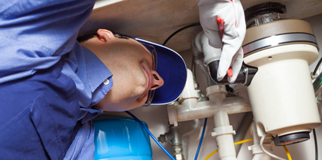Top Tips for Fixing a Leaking Waste Disposal Unit
Click HereOn this page down the page you can discover a good deal of incredibly good tips when it comes to Garbage Disposal Leaking From Bottom.

Garbage disposals are important kitchen area devices that help in taking care of food waste effectively. Nevertheless, a leaking waste disposal unit can be an aggravating and untidy trouble to deal with. Luckily, several leakages can be fixed easily with a couple of straightforward actions. In this write-up, we will certainly review how to deal with a leaking waste disposal unit efficiently.
Intro
Waste disposal unit are set up under kitchen area sinks and are designed to shred food waste into smaller sized pieces, permitting it to go through the pipes system quickly. While these gadgets are normally reliable, leakages can occur over time as a result of deterioration, loosened connections, or damages to the device.
Common Reasons For Leakages in Waste Disposals
Worn Seals and Gaskets
Seals and gaskets play an important function in protecting against water from dripping out of the waste disposal unit. With time, these parts can degrade, causing leakages around the disposal unit.
Loose Connections
The links in between the waste disposal unit and the pipes system can end up being loose with time, triggering water to leak out throughout operation.
Cracks or Openings in the Disposal Device
Physical damage to the waste disposal unit, such as fractures or openings in the housing, can additionally lead to leakages.
Determining the Source of the Leakage
Before attempting to fix a leaking waste disposal unit, it is necessary to recognize the source of the leak. This can commonly be done via visual evaluation or by performing simple tests.
Visual Assessment
Evaluate the waste disposal unit unit thoroughly for any kind of signs of water leakage. Pay close attention to areas around seals, gaskets, and connection points.
Evaluating for Leaks
One way to evaluate for leaks is by running water with the disposal system and checking for any type of visible signs of leakage.
Devices and Materials Needed for Fixing a Dripping Garbage Disposal
Prior to beginning the repair service process, collect the needed tools and products, consisting of a screwdriver, adjustable wrench, plumbing technician's putty, replacement seals or gaskets, and epoxy or patching product for fixing fractures or openings.
Step-by-Step Guide to Dealing With a Leaking Waste Disposal Unit
Switch off the Power
Prior to trying any repair work, make certain that the power to the waste disposal unit device is switched off to prevent the danger of electric shock.
Situate the Leak
Recognize the exact place of the leakage and identify the reason.
Tighten Links
Make use of a wrench to tighten any type of loosened links in between the disposal unit and the plumbing system.
Replace Seals or Gaskets
If the leak is due to worn seals or gaskets, remove the old elements and replace them with new ones.
Patching Cracks or Holes
For fractures or holes in the disposal device, usage epoxy or an ideal patching material to secure the damaged location.
Testing the Garbage Disposal After Repair
As soon as the repair is full, test the waste disposal unit by running water with it to make certain that the leak has actually been fixed.
Preventive Upkeep Tips to Stay Clear Of Future Leakages
To avoid future leaks, it is vital to execute regular maintenance on your waste disposal unit. This consists of keeping it tidy, preventing placing non-food things or difficult things down the disposal, and periodically checking for leaks or other concerns.
Conclusion
In conclusion, fixing a dripping garbage disposal is a fairly uncomplicated process that can be completed with standard devices and materials. By following the actions described in this article and exercising precautionary maintenance, you can maintain your waste disposal unit in good working problem and avoid costly fixings in the future.
HERE’S HOW TO FIX YOUR GARBAGE DISPOSAL
WHAT TO DO IF SOMETHING IS STUCK IN YOUR GARBAGE DISPOSAL
If the impeller won’t turn, there’s probably something stuck in the disposal. It could be a steak bone or peach pit, although plumbers report pulling all sorts of inappropriate objects out of disposals, such as bottle caps or aluminum foil. Make sure power to the disposal is off, and look inside to see if you can see the source of the jam.
Never stick your fingers in a disposal. Pull out anything you see with tongs or pliers.
If the disposal still won’t work, it may be time to call a plumber or consider buying a new disposal. GEM Plumbing & Heating is here for all of your garbage disposal needs.
WHAT TO DO IF YOUR GARBAGE DISPOSAL DRAIN IS CLOGGED
Take everything out from underneath your sink and put a bucket or other container under your disposal to catch any water that drains out. Disconnect your disposal from the power supply. If it’s plugged into a wall outlet, unplug it. If it’s hardwired into an electrical box, go to the electrical panel and turn off the breaker for the disposal. Pour ¼ cup of baking soda into the drain, followed by ½ cup of white vinegar. Give the solution a few minutes to fizz and do its work. Look into the disposal with a flashlight to see if you can see an object that might be causing the clog. If you see it, remove it using tongs or pliers. MORE TIPS ON DEALING WITH A CLOGGED GARBAGE DISPOSAL
Never use drain cleaner in a garbage disposal. It can damage the plastic parts inside the disposal. You can also be splashed with the caustic liquid while working to clear the clog. Beware! Never stick your fingers into a garbage disposal. Trust us — not a good idea. In many instances, your dishwasher drains through your garbage disposal. This allows the disposal to grind any large food particles that may be drained out of your dishwasher. There are some jurisdictions, however, where the plumbing code prohibits such a connection. WHAT TO DO WHEN YOUR DISHWASHER DRAINS THROUGH THE DISPOSAL
Run some water in the sink so your plunger has at least a ½-inch of water to create a seal and plunge vigorously up and down several times. You may need to repeat this several times. Run hot water down the drain to clear any residue that remains.

I discovered that piece on Why Is while doing a search on the web. Sharing is good. Helping others is fun. Thanks a lot for your time. Don't hesitate to pay a visit to our blog back soon.
Get An Estimate